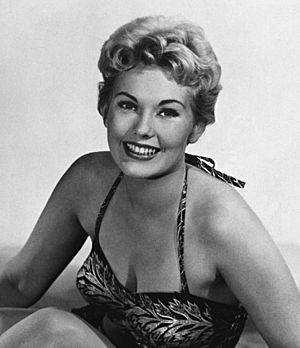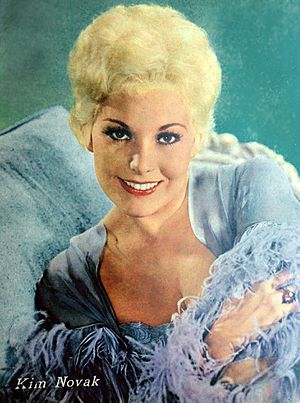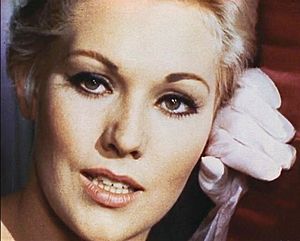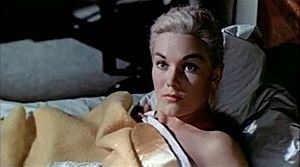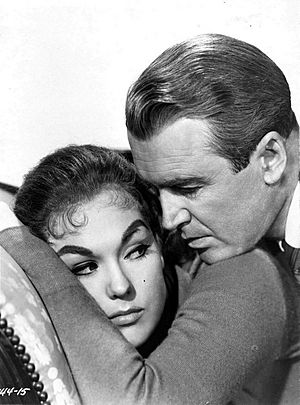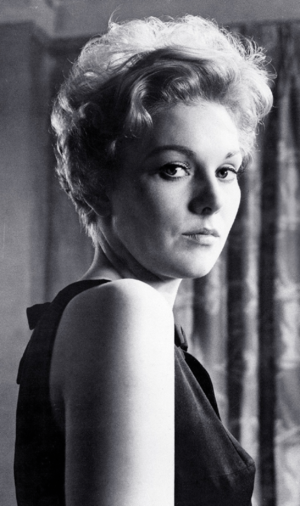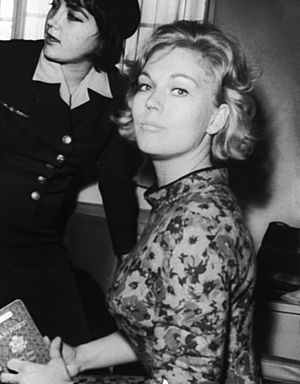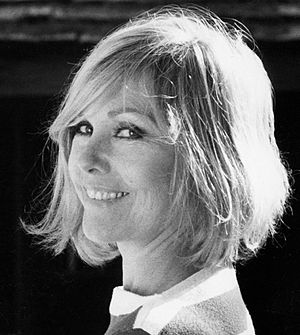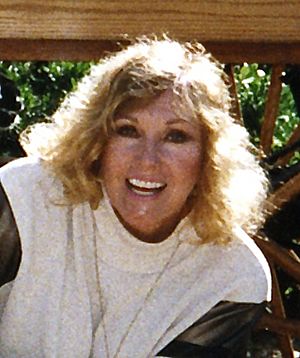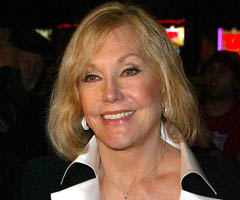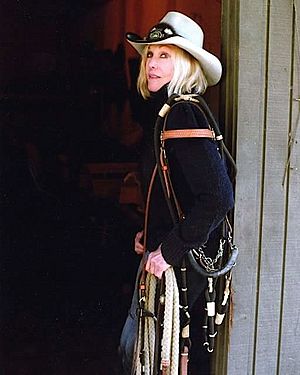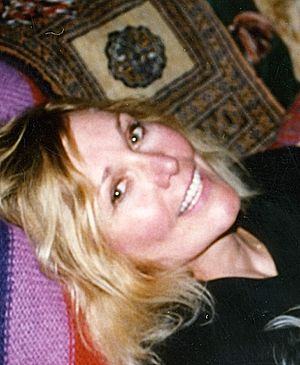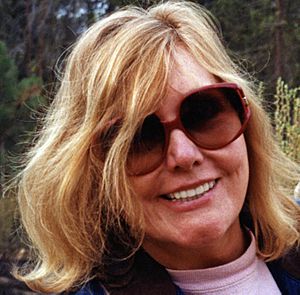Kim Novak facts for kids
Marilyn Pauline "Kim" Novak (born February 13, 1933) is an American actress who is now retired. She is also a talented painter. Kim Novak has received many awards for her work in movies. These include two Golden Globe Awards and a special award called an Honorary Golden Bear. She also has a star on the famous Hollywood Walk of Fame.
Novak started her acting career in 1954. She signed a contract with Columbia Pictures. Soon, she became one of the most popular movie stars in Hollywood. She starred in famous films like Picnic (1955), The Man with the Golden Arm (1955), and Pal Joey (1957). She became very well-known for her role in Alfred Hitchcock's thriller Vertigo (1958). Many people consider Vertigo to be one of the greatest films ever made. Other important movies she made include Bell, Book and Candle (1958) and Strangers When We Meet (1960).
Even though she was still quite young, Novak stopped acting regularly around 1966. Since then, she has only appeared in a few films. She was in The Mirror Crack'd (1980) and had a role on the TV show Falcon Crest (1986–1987). After a difficult experience making the movie Liebestraum (1991), she decided to retire from acting for good.
Contents
Kim Novak's Early Life and Education
Marilyn Pauline Novak was born in Chicago, Illinois, on February 13, 1933. She was the second daughter of Joseph and Blanche Novak. Her parents were both born in Chicago and had Czech family backgrounds. Her father, Joseph, was a history teacher. During the Great Depression, he worked as a train dispatcher for a railroad company.
Kim went to William Penn Elementary and Farragut High School. She also attended Wright Junior College. She earned two scholarships to study at the School of the Art Institute of Chicago. During a summer break from college, Novak traveled across the country. She worked as a model for a refrigerator company at trade shows.
Kim Novak's Acting Career Journey
Starting Out: Early Films and Big Success
After her modeling tour ended in San Francisco, Novak and two other models went to Los Angeles. They wanted to see what the movie industry was like. In Los Angeles, Marilyn Novak worked as an extra in a few films. These included Son of Sinbad (filmed in 1953) and The French Line (1953). An agent discovered her in Los Angeles. She then signed a long contract with Columbia Pictures.
From the very beginning, Kim wanted to be unique. She did not want to be just another typical actress. She had a disagreement with Harry Cohn, the head of Columbia Pictures, about changing her name. He suggested "Kit Marlowe," saying her real name sounded too foreign. But she insisted on keeping her name. They finally agreed on "Kim Novak" as a compromise.
Columbia Pictures wanted Novak to be their next big star. They hoped she would be as successful as Rita Hayworth had been in the 1940s. They also hoped she would bring them as much success as Marilyn Monroe brought to another studio. Novak's first movie for Columbia was Pushover (1954). She then co-starred in the comedy Phffft (1954). Both movies did well, and Novak received good reviews for her acting. Her third movie, 5 Against the House (1955), was a crime drama.
Next, she played Madge Owens in the movie Picnic (1955). She starred alongside William Holden. The director, Joshua Logan, thought red hair would suit her character better. So, she wore a red wig for the film. Picnic was a huge success with critics and at the box office. Novak won a Golden Globe Award for Most Promising Newcomer. She was also nominated for a BAFTA Film Award. After this, director Otto Preminger cast her in The Man with the Golden Arm (1955). She played the ex-girlfriend of Frank Sinatra's character. Novak received praise for her role, and the movie was a hit.
Novak's next film was The Eddy Duchin Story (1956). She played Marjorie Oelrichs, the wife of pianist Eddy Duchin. The film was a success. She then chose to star in Jeanne Eagels (1957). In this movie, she played the famous stage and silent-screen actress. The film received negative reviews but still made money.
After several successful movies, Novak became one of the biggest box-office stars in 1957 and 1958. Columbia then put her in the movie Pal Joey (1957). This film was based on a novel and Broadway play. She played Linda English, a sweet showgirl. She starred again with Frank Sinatra and also with Rita Hayworth. The movie was released in October and received good reviews. Pal Joey was a box-office hit and is considered one of Novak's better performances.
1958: The Iconic Role in Vertigo
Director Alfred Hitchcock was making his film Vertigo (1958). His main actress, Vera Miles, became pregnant and could not do the role. Hitchcock asked Harry Cohn to offer Novak the lead female part. Cohn did not like the script, but he let Novak read it because Hitchcock was a great director. Novak loved the script. She felt she could understand the character. She agreed to be in the film without even meeting Hitchcock.
At the same time, Novak was trying to get more money from Columbia Pictures. She refused to show up for work on the Vertigo set. She was protesting her low salary of $1,250 a week. Novak hired new agents and demanded a better contract. Cohn, who was paid a lot of money for Novak to do Vertigo, stopped her pay. But after a few weeks, he agreed and offered her a new contract. She now earned $3,000 a week. She told the press, "I don't like to have anyone take advantage of me."
Novak finally started working on the film. Hitchcock said she had "all sorts of preconceived notions" about her character. She did not like the gray suit and black shoes she was supposed to wear. She thought they were too heavy for her character. Novak later remembered, "I didn't think it would matter to him what kind of shoes I wore." Hitchcock explained that the look of the film was very important to him. He insisted she wear the suit and shoes he had planned. Novak learned to make it work for her. She saw the suit as a symbol of her character.
Hitchcock allowed Novak to develop the character herself. She later said, "It excites me to work on dual personalities because I think I have many myself." She felt she could use a lot of herself in the movie. She identified with the character's journey. The role became very personal for her. She felt she went through something similar when she came to Hollywood.
Novak described Hitchcock as a gentleman. But she found working with him strange. She said, "I don't know if he ever liked me." She felt he was frustrated because he wanted Vera Miles instead of her. Novak said, "Hitchcock didn't like having me in his picture and he felt I was ruining it." She felt she did good work and got good reviews. But she believed Hitchcock blamed her because he could not blame himself.
Novak got along well with her co-star, James Stewart. He supported her during filming. She said, "He treated me so well. I learned a lot about acting from him." When they had emotional scenes, he would prepare himself. She knew to leave him alone during this time. After the scene, he would slowly come out of it. She said, "He'd hold my hand and I would squeeze his hand." This helped them both calm down.

When Vertigo was first released in 1958, it received mixed reviews. It also just barely made its money back. But over time, people have changed their minds. It is now seen as one of Hitchcock's best films. In 2012, a survey by the British Film Institute voted Vertigo the best film of all time. It took the top spot from Citizen Kane. Novak's performance also received mixed reviews at first. But critics were surprised. Bosley Crowther of The New York Times called her "really quite amazing." Over time, opinions on her acting changed. Film critic David Thomson called it "one of the major female performances in the cinema." Director Martin Scorsese called it "extraordinary." However, Novak herself was disappointed when she watched the film in 2013. She felt her characters were "exaggerated."
Later Career and Stepping Away from Hollywood
Novak worked with James Stewart again in Bell, Book and Candle (1958). This was a comedy about modern-day witchcraft. It also starred Jack Lemmon. The movie was a box-office success. Then, she starred with Fredric March in the drama Middle of the Night (1959). Novak has said this is her favorite film and her best performance.
Novak starred with Kirk Douglas in the drama Strangers When We Meet (1960). This film received mixed reviews but made money. The director, Richard Quine, was her fiancé at the time. The studio planned to give them the house built for the movie as a wedding gift. But they never got married. Instead, while making her next film with Quine, The Notorious Landlady (1962), she found her future home. It was a house by the sea near Big Sur in California. This place became her escape after leaving Hollywood.
She signed a deal to make five independent films. But this did not go well because of disagreements over scripts. Their first movie, Boys' Night Out (1962), was not successful. After her Hollywood house survived a big fire in 1961, it was later destroyed. A mudslide in 1966 swept it away with most of her belongings. During this time, she made the drama Of Human Bondage (1964) in Ireland. This film went over budget and also failed.
The comedy Kiss Me, Stupid (1964) followed, directed by Billy Wilder. The film had problems getting released. It opened to very bad reviews. While it made money, it did not help Novak's career. Years later, the film was re-evaluated and praised for being ahead of its time. Novak's performance as "Polly the Pistol" received great reviews.
Novak starred in The Amorous Adventures of Moll Flanders (1965) in England. She married her co-star, Richard Johnson, in 1965. They divorced in 1966 but remained friends. In 1966, Novak was cast in the mystery Eye of the Devil. She had to leave the film after falling off a horse. She was seriously injured and was replaced by Deborah Kerr.
Acting Less Often: 1966–1991
By the end of 1966, Kim Novak was tired of being a Hollywood movie star. She did not want the press watching her every move. When a mudslide destroyed her home in Bel Air, she moved away to Big Sur. From then on, acting became just a job for her, not her main passion. Novak wanted to focus on her love for art. She often wrote poetry to go with her paintings. She even wrote some song lyrics.
Novak returned to movies for The Legend of Lylah Clare (1968). She played two roles. The director, Robert Aldrich, asked her to use a German accent. But she felt it was not believable. At the premiere, Novak was shocked to hear her voice had been dubbed by a German actress in many scenes. Aldrich had not told her. The film was heavily criticized and was a box office failure. Novak was very upset and regretted being in it. Her last film in the 1960s was the Western comedy The Great Bank Robbery (1969).
After almost four years away, Novak agreed to two projects. She appeared in the horror film Tales That Witness Madness (1973). Novak also starred in the TV movie The Third Girl From the Left (1973). She liked TV films because they were faster to make. In 1975, Novak was in the TV movie Satan's Triangle. She had a small role in the Western The White Buffalo (1977). She ended the decade playing Helga in Just a ... (1979). Both films did not do well, but Novak was not blamed.
In 1980, Novak played Lola Brewster in the British mystery-thriller The Mirror Crack'd. This film was based on a story by Agatha Christie. She enjoyed making the film and got along with the other actors. The film was moderately successful. Novak did not appear in any feature films for the rest of the 1980s. She was in the TV movie Malibu (1983). She also appeared in the pilot episode of The New Alfred Hitchcock Presents (1985).
Producers of the TV show Falcon Crest offered Novak a role. She played the mysterious "Kit Marlowe" in 19 episodes from 1986 to 1987. It was Novak's idea to name her character Kit Marlowe. This was the stage name that Columbia Pictures had wanted her to use when she started acting.
In 1989, Novak appeared with James Stewart at the 61st Academy Awards. She was asked about returning to acting. Novak said she would consider it if she found a script she really loved. At the same time, Novak turned down many movie offers. She also said no to a second season of Falcon Crest. She wanted to write her autobiography, called Through My Eyes. Novak decided to look for challenging roles because she was not satisfied artistically. She returned to film in The Children (1990). This film received good reviews, and her performance was praised. However, the film was never widely released due to problems between the director and distributor.
Director Mike Figgis offered Novak a role in his thriller Liebestraum (1991). Novak loved the script. However, working with Figgis was difficult. They had disagreements from the start. Novak felt he wanted her to act like a puppet. She said, "It was such a painful thing for me." She felt it reminded her of her early struggles in Hollywood. Novak later said she was "unprofessional" for not following her director's wishes. She felt the role was amazing, but he wanted her to just say the lines. She said he threatened to cut her out of the movie, and he mostly did.
After the difficult experience with Liebestraum, Novak decided to retire from the film industry. She said in 2004, "I got so burned out on that picture that I wanted to leave the business." She added that making a movie is wonderful, but selling it afterward is hard.
Life After Acting: Retirement and Art
After retiring from acting, Novak rarely made public appearances. She turned down most offers she received. In 1996, her film Vertigo was restored and re-released. Novak enjoyed the restoration work. She agreed to appear at screenings of the film. She also took part in a documentary about the making of Vertigo. In 1997, Novak received an Honorary Golden Bear Award for her lifetime achievements at the 47th Berlin International Film Festival.
In 2003, Novak received the Eastman Kodak Archives Award for her important contributions to film. Many famous actors and directors have received this award. During this time, Novak received offers for major films and TV shows. She appeared on Larry King Live in 2004. She said she would consider returning to acting "if it was the right role." In 2010, Novak was honored by the American Cinematheque in Hollywood. Her films were shown, and she made a rare appearance for a Q&A session. She received a two-minute standing ovation.
In April 2012, Novak was honored at the TCM Classic Film Festival. She introduced a screening of Vertigo. She also had a conversation with Robert Osborne. During this interview, she talked about her career and personal life. Novak became emotional when discussing Liebestraum. She said, "I couldn't do a movie after that. I've never done a movie after that." She also revealed that she was bipolar. She explained, "I was not diagnosed until much later." She felt she was "never cut out to have a Hollywood life." Novak also said, "Did I do the right thing, leaving? Did I walk out when I shouldn't have? That's when I get sad." When asked about acting again, she said, "Who knows what the future holds? I would never say never." That same year, Novak was honored with a handprint and footprint ceremony at Grauman's Chinese Theatre. She also received the San Francisco Cinematic Icon Award.
After many years of living privately, Novak started making more public appearances. She felt her work was being appreciated more. In 2013, she was the guest of honor at the Cannes Film Festival. She introduced a newly restored version of Vertigo. She also presented at the festival's closing ceremony and received a standing ovation.
In 2014, she was a presenter at the 86th Academy Awards. That same year, she appeared at the TCM Classic Film Festival. She showed her painting called Vertigo / Vortex of Delusion. This painting was made for TCM's 20th anniversary. Novak also introduced a screening of her 1958 movie, Bell Book and Candle. Also in 2014, Novak was a speaker on a cruise from New York to London. She introduced screenings of her films and did a Q&A session. That year, she also had a solo art show of her paintings.
In 2015, Novak attended the 22nd Febiofest international film festival. She received the Kristián Award for her contributions to world cinema. She also had an exhibition of her paintings. She hosted special screenings of Vertigo with live orchestra music. In 2016, Novak was a guest on a Turner Classic Movies cruise. She sold five of her paintings and raised almost $7,000 for charity.
In 2018, Novak had a Q&A session with Larry King at the Grauman's Egyptian Theatre. This was to celebrate Vertigo's 60th Anniversary. That same year, she was honored at the Castro Theatre.
Kim Novak's Achievements and Awards
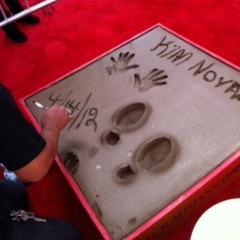
In 1955, Novak won the Golden Globe Award for Most Promising Newcomer – Female. Two years later, she won another Golden Globe for World Favorite Female Actress. On February 8, 1960, Novak received a star on the Hollywood Walk of Fame. Her star is located at 6332 Hollywood Boulevard.
Novak was honored with a Golden Bear for Lifetime Achievement in 1997. This was at the 47th Berlin International Film Festival. In 2003, she received the Eastman Kodak Archives Award for her major contributions to film. In 2012, Novak was honored at Grauman's Chinese Theatre with a handprint and footprint ceremony. That same year, she received the S.F. Cinematic Icon Award. This was for her work in films like Pal Joey and Vertigo, which were set in San Francisco. Her contributions to world cinema were also recognized with the Kristián Award in 2015.
Kim Novak has inspired many actors and fashion designers. Naomi Watts said that her character in Mulholland Drive (2001) was influenced by Novak's look in Vertigo. Renée Zellweger called Novak "pure magic." Nicole Kidman wrote Novak a letter. She said Novak was "an inspiration to me and to women everywhere." Kidman praised Novak's acting and her choice to leave Hollywood. She called Novak "an icon whose screen presence is unmatched." In 2005, fashion designer Alexander McQueen named his first famous handbag "The Novak." He said he was drawn to Kim Novak just like Hitchcock was.
Kim Novak's Personal Life
In the mid-1950s, Novak had relationships with several people. She was engaged to director Richard Quine in 1959. Novak's first marriage was to English actor Richard Johnson. They were married from March 15, 1965, to May 26, 1966. They remained friends after their divorce.
In 1966, Novak left Hollywood and moved to Big Sur. There, she raised horses and focused on her painting. She made films only sometimes. In 1974, she met her second husband, Robert Malloy. He was a veterinarian for horses. They married on March 12, 1976. Through her marriage, she gained two adult stepchildren. The couple built a log home near the Williamson River in Chiloquin, Oregon. Robert Malloy passed away on November 27, 2020.
In 1997, Novak and Malloy bought a ranch in Sams Valley, Oregon. This became their home. Novak took art classes to improve her painting skills. In July 2000, their home burned down. She lost all her artwork and the only copy of her autobiography. In 2006, Novak was injured in a horse-riding accident. She had a punctured lung, broken ribs, and nerve damage. But she fully recovered within a year.
In October 2010, her manager announced that Novak had been diagnosed with breast cancer. She underwent treatment and made a full recovery.
In 2014, Novak made a rare public appearance at the 86th Academy Awards. Some media and social comments suggested she looked very different. This led to talk about cosmetic surgery. Donald Trump even tweeted about it. Novak was very upset by the criticism. She wrote an open letter defending herself. Novak admitted she had "fat injections in my face." She thought they seemed less invasive than a face-lift. But she later regretted it. She said, "I trusted somebody doing what I thought they knew how to do best."
Novak continues to be creative as a photographer, poet, and artist. Her paintings are in the style of impressionism and surrealism. The Butler Institute of American Art in Ohio held a show of her work from June to October 2019. Novak was there for the opening. In 2021, a book of her paintings called Kim Novak: Her Art and Life was published. More of her artworks were shown at the Butler Institute from June to August 2024.
Kim Novak's Filmography
| Year | Title | Role | Notes |
|---|---|---|---|
| 1954 | The French Line | Model | Uncredited |
| Pushover | Lona McLane | ||
| Phffft | Janis | ||
| 1955 | Son of Sinbad | Harem Girl | Uncredited |
| 5 Against the House | Kay Greylek | ||
| Picnic | Marjorie "Madge" Owens | ||
| The Man with the Golden Arm | Molly Novotny | ||
| 1956 | The Eddy Duchin Story | Marjorie Oelrichs | |
| 1957 | Jeanne Eagels | Jeanne Eagels | |
| Pal Joey | Linda English | ||
| 1958 | Vertigo | Judy Barton / Madeleine Elster | |
| Bell, Book and Candle | Gillian "Gil" Holroyd | ||
| 1959 | Middle of the Night | Betty Preisser | |
| 1960 | Strangers When We Meet | Margaret "Maggie" Gault | |
| Pepe | Herself | Cameo | |
| 1962 | The Notorious Landlady | Mrs. Carlyle "Carly" Hardwicke | |
| Boys' Night Out | Cathy | ||
| 1964 | Of Human Bondage | Mildred Rogers | |
| Kiss Me, Stupid | Polly the Pistol | ||
| 1965 | The Amorous Adventures of Moll Flanders | Moll Flanders | |
| 1968 | The Legend of Lylah Clare | Lylah Clare/Elsa Brinkmann/Elsa Campbell | |
| 1969 | The Great Bank Robbery | Sister Lyda Kebanov | |
| 1973 | Tales That Witness Madness | Auriol Pageant | Segment #4 "Luau" |
| The Third Girl from the Left | Gloria Joyce | Television film | |
| 1975 | Satan's Triangle | Eva | |
| 1977 | The White Buffalo | Mrs. Poker Jenny Schermerhorn | Alternative title: Hunt to Kill |
| 1979 | Just a ... | Helga von Kaiserling | |
| 1980 | The Mirror Crack'd | Lola Brewster | |
| 1983 | Malibu | Billie Farnsworth | Television film |
| 1990 | The Children | Rose Sellars | |
| 1991 | Liebestraum | Lillian Anderson Munnsen | Final film appearance (to date) |
Awards and Nominations for Kim Novak
| Year | Award | Category | Title of work | Result |
|---|---|---|---|---|
| 1955 | Golden Globe Award | Most Promising Newcomer - Female | Phffft | Won |
| 1956 | Photoplay Awards | Most Popular Female Star | N/A | Won |
| 1957 | Golden Globe Award | World Film Favorite - Female | N/A | Won |
| BAFTA Awards | Best Foreign Actress | Picnic | Nominated | |
| Golden Apple Award | Most Cooperative Actress | N/A | Won | |
| 1960 | Hollywood Walk of Fame | Motion Picture Star | N/A | Won |
| 1958 | Laurel Awards | Top Female Star | N/A | 3rd place |
| 1959 | N/A | 12th place | ||
| 1960 | N/A | 8th place | ||
| 1961 | N/A | 6th place | ||
| 1962 | N/A | 13th place | ||
| 1963 | N/A | 11th place | ||
| 1997 | 47th Berlin International Film Festival | Honorary Golden Bear | N/A | Won |
| 2003 | George Eastman Museum | George Eastman Award | N/A | Won |
| 2012 | San Francisco Museum and Historical Society | S.F. Cinematic Icon Award | N/A | Won |
| 2015 | Febiofest | Kristián Award | N/A | Won |
See also
 In Spanish: Kim Novak para niños
In Spanish: Kim Novak para niños


